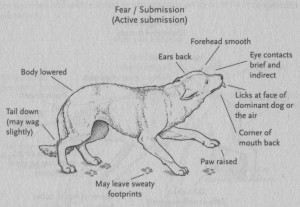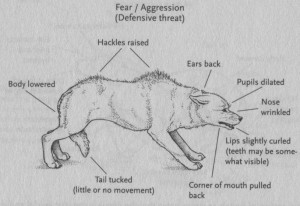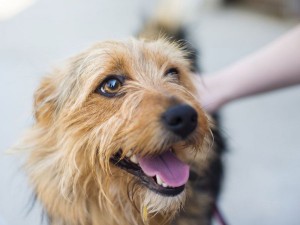Just like us humans, dogs too can experience anxiety. Here we are going to help you understand how to recognise anxiety and we’ll then walk you through various steps and training processes to best manage a dog that is showing signs of anxiety.
Recognise the Anxiety
Physical signs of anxiety
- The dog sits or walks crouched
- The ears are set back
- Heavy shaking
- The tail is low or hidden between the legs
- The muscles are tense
- Fast breathing
Other signs
- Barking, growling, whining and biting
- Hiding behind people or objects
- Sudden urinating
Different types of anxiety
Fear is a natural behavioral reaction to a person or object which prepares the dog’s body to ‘freeze, fight or flight’.
Phobia is a fear of a specific noise or object, like the sound of thunderstorm. All noises similar to that will also generate a response.
Anxiety is a fear of dangers that could possibly happen in the future. The dog is very attentive and all kind of small changes in the environment can scare him. Depending on the phase, the dog is easily irritable and gets aggressive, as well as having a constant defensive attitude. Anxiety can also trigger actions that the dog is doing in order to relieve the dog’s stresses. Those actions can be continuous drinking or eating, licking their paws or excessive attachment to their owner.
Causes for anxiety
One cause can be a bad experience in the past with humans, objects or other animals. Unfortunately from an early age many dogs get treated really badly. Sadly they may get hit, put into a small cage over a long period or they don’t receive food for days. Especially in the growth phase of the dog’s upbringing, these experiences have a big influence on their further development.
Furthermore, a drastic change in daily routine or life can trigger anxieties. Some dogs are sensitive to all kind of changes in their environment. This can be a death of their caregiver or another dog that was part of the family.
Also a very important part is the process of the socialisation phase. In some cases, the mother of the dogs does not take good care of their puppies, either because she is not physically or psychologically able to do so. A good start into the life for a puppy is dependent on the mother giving them body care and body protection, to feed them properly and show them social competencies.
Training
Desensitisation
In this form of therapy, the dog gets confronted with the anxiety in a way that it is still bearable. The goal of this is to weaken the dog’s reaction to the person, object or situation he is scared of step by step. If the dog is scared of a vacuum cleaner, the first step might be to put it in the same room with the pooch, but with the opportunity for him to leave the room until the dog is comfortable with it. The next step could be to have it in the same room and close the doors. It is important that ‘baby steps’ are taken when doing this and when noticing that the dog is too anxious, you should stop it and try again another time. Don’t force your dog or you might intensify the reactions. If you are not comfortable doing this on your own, look for a professional to help you.
Deconditioning
 This is a method of replacing a specific action or behaviour with another one. The new reaction should be easy and not very complex. When your dog is barking at other dogs, the new action could be just looking at you. Those situations should first be trained at home or with dogs of friends. Only when it works in a quiet and known environment, it will work in real life situations.
This is a method of replacing a specific action or behaviour with another one. The new reaction should be easy and not very complex. When your dog is barking at other dogs, the new action could be just looking at you. Those situations should first be trained at home or with dogs of friends. Only when it works in a quiet and known environment, it will work in real life situations.
Conditioned relaxation
When a dog gets confronted with the trigger of his anxiety, the dog gets nervous, upset or angry. In that condition the dog is less likely to listen to you, because he doesn’t notice you and is focused on his other feelings. To get your dog to listen to you, he must be more relaxed. The state of relaxation is trainable. One approach can be, that every time your dog starts to relax at home, you have to say a word or show a signal. This has to be done a couple of times until you pooch connects those signals to a relaxed state. Once your dog realises the connection and your dog gets angry or nervous again, use the word or signal to show your him to relax again.
What to keep in mind while training the dog
Don’t show pity
When you try to spoil your pooch and give more treats than usual for example, even though the behaviour is not right, the dog starts to think that he receives treats for that kind of behaviour which only supports it.
Be patient
The dog won’t change or feel better after one day of training. It takes some time, to earn the trust of your fur-child and to make him feel more comfortable.
Praise your dog for right behaviour
As important it is not to praise your dog with treats for wrong behaviour, it is very important to do so when he does something right. This encourages the actions and your pooch will learn to understand what is right and what is wrong.
Keep distance
Keep an eye on your dog’s body language. Dogs with an anxiety often don’t want to let some people close or they just need some distance. When you see your pooch turning his head away from you, licking his snout or yawning, he shows you to keep distance. When the dog has to start barking or biting to get you to move away, you’re doing something wrong.
Be relaxed
Your behaviour and feeling reflects on your furry friend. Dogs can feel when you are hectic and they start to get nervous, too. Always try to communicate a calm feeling and your dog will do the same.
Don’t force your dog
Never force your pooch to any actions. The goal of the training is that he does everything voluntarily and you earn his trust.
Before starting with the training talk to your vet first and if you are not comfortable with training your dog on your own, ask a professional to help you.
Importantly, let your dog minder know in advance if your dog has experienced anxiety in the past or shows a strong reaction in specific situations or to objects. Some of our pet sitters might have experience with dog anxiety and can give some tips.
